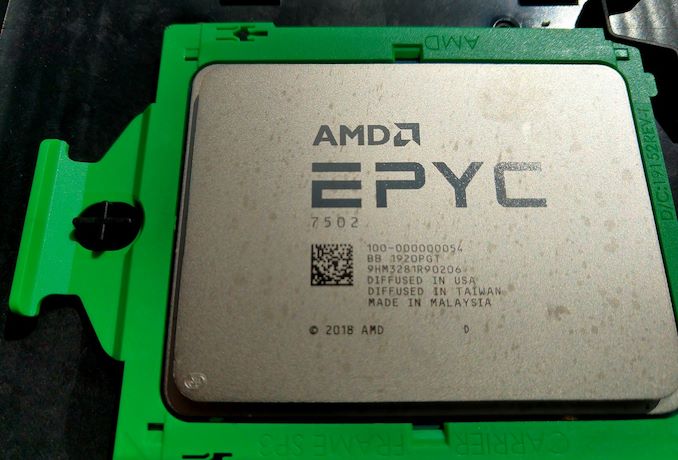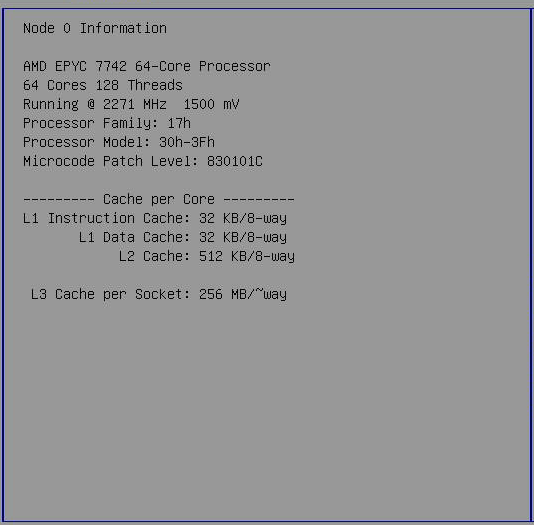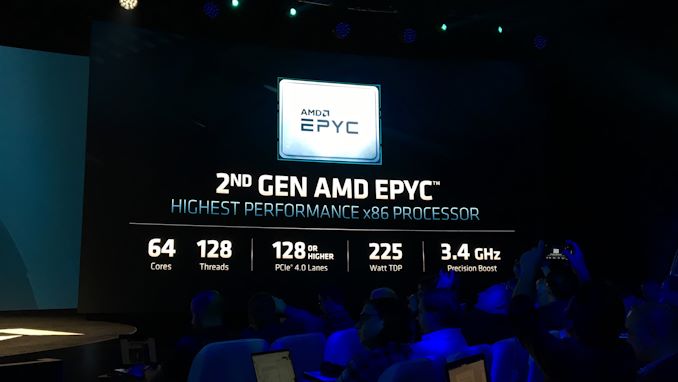AMD Rome Second Generation EPYC Review: 2x 64-core Benchmarked
by Johan De Gelas on August 7, 2019 7:00 PM EST
If you examine the CPU industry and ask where the big money is, you have to look at the server and datacenter market. Ever since the Opteron days, AMD's market share has been rounded to zero percent, and with its first generation of EPYC processors using its new Zen microarchitecture, that number skipped up a small handful of points, but everyone has been waiting with bated breath for the second swing at the ball. AMD's Rome platform solves the concerns that first gen Naples had, plus this CPU family is designed to do many things: a new CPU microarchitecture on 7nm, offer up to 64 cores, offer 128 lanes of PCIe 4.0, offer 8 memory channels, and offer a unified memory architecture based on chiplets. Today marks the launch of Rome, and we have some of our own data to share on its performance.
Review edited by Dr. Ian Cutress
First Boot
Sixty-four cores. Each core with an improved Zen 2 core, offering ~15% better IPC performance than Naples (as tested in our consumer CPU review), and doubled AVX2/FP performance. The chip has a total of 256 MB of L3 cache, and 128 PCIe 4.0 lanes. AMD's second generation EPYC, in this case the EPYC 7742, is a behemoth.
Boot to BIOS, check the node information.
[Note: That 1500 mV reading in the screenshot is the same reading we see on consumer Ryzen platforms; it seems to be the non-DVFS voltage as listed in the firmware, but isn't actually observed]
It is clear that the raw specifications of our new Rome CPU is some of the most impressive on the market. The question then goes to whether or not this is the the new fastest server chip on the market - a claim that AMD is putting all its weight behind. If this is the new fastest CPU on the market, the question then becomes 'by how much?', and 'how much does it cost?'.
I have been covering server CPUs since the launch of the Opteron in 2003, but this is nothing like I have seen before: a competitive core and twice as much of them on a chip than what the competition (Intel, Cavium, even IBM) can offer. To quote AMD's SVP of its Enterprise division, Forrest Norrod:
"We designed this part to compete with Ice Lake, expecting to make some headway on single threaded performance. We did not expect to be facing re-warmed Skylake instead. This is going to be one of the highlights of our careers"
Self-confidence is at all times high at AMD, and on paper it would appear to be warranted. The new Rome server CPUs have improved core IPC, a doubling of the core count at the high end, and it is using a new manufacturing process (7 nm) technology in one swoop. Typically we see a server company do one of those things at a time, not all three. It is indeed a big risk to take, and the potential to be exciting if everything falls into place.
To put this into perspective: promising up to 2x FP performance, 2x cores, and a new process technology would have sounded so odd a few years ago. At the tail end of the Opteron days, just 4-5 years ago, Intel's best CPUs were up to three times faster. At the time, there was little to no reason whatsoever to buy a server with AMD Opterons. Two years ago, EPYC got AMD back into the server market, but although the performance per dollar ratio was a lot better than Intel's, it was not a complete victory. Not only was AMD was still trailing in database performance and AVX/FP performance, but partners and OEMs were also reluctant to partner with the company without a proven product.
So now that AMD has proven its worth with Naples, and AMD promising more than double the deployed designs of Rome with a very quick ramp to customers, we have to compare the old to the new. For the launch of the new hardware, AMD provided us with a dual EPYC 7742 system from Quanta, featuring two 64-core CPUs.












180 Comments
View All Comments
AnonCPU - Friday, August 9, 2019 - link
The gain in hmmer on EPYC with GCC8 is not due to TAGE predictor.Hmmer gains a lot on EPYC only because of GCC8.
GCC8 vectorizer has been improved in GCC8 and hmmer gets vectorized heavily while it was not the case for GCC7. The same run on an Intel machine would have shown the same kind of improvement.
JohanAnandtech - Sunday, August 11, 2019 - link
Thanks, do you have a source for that? Interested in learning more!AnonCPU - Monday, August 12, 2019 - link
That should be due to the improvements on loop distribution:https://gcc.gnu.org/gcc-8/changes.html
"The classic loop nest optimization pass -ftree-loop-distribution has been improved and enabled by default at -O3 and above. It supports loop nest distribution in some restricted scenarios;"
There are also some references here in what was missing for hmmer vectorization in GCC some years ago:
https://gcc.gnu.org/ml/gcc/2017-03/msg00012.html
And a page where you can see that LLVM was missing (at least in 2015) a good loop distribution algo useful for hmmer:
https://www.phoronix.com/scan.php?page=news_item&a...
AnonCPU - Monday, August 12, 2019 - link
And more:https://community.arm.com/developer/tools-software...
just4U - Friday, August 9, 2019 - link
I guess the question to ask now is can they churn these puppies out like no tomorrow? Is the demand there? What about other Hardware? Motherboards and the like..Do they have 100 000 of these ready to go? The window of opportunity for AMD is always fleeting.. and if their going to capitalize on this they need to be able to put the product out there.
name99 - Friday, August 9, 2019 - link
No obvious reason why not. The chiplets are not large and TSMC ships 200 million Apple chips a year on essentially the same process. So yields should be there.Manufacturing the chiplet assembly also doesn't look any different from the Naples assembly (details differ, yes, but no new envelopes being pushed: no much higher frequency signals or denser traces -- the flip side to that is that there's scope there for some optimization come Milan...)
So it seems like there is nothing to obviously hold them back...
fallaha56 - Saturday, August 10, 2019 - link
Perhaps Hypertheading should be off on the Intel systems to better reflect eg Google’s reality / proper security standards now we know Intel isn’t secure?Targon - Monday, August 12, 2019 - link
That is why Google is going to be buying many Epyc based servers going forward. Mitigations do not mean a problem has been fixed.imaskar - Wednesday, August 14, 2019 - link
Why do you think AWS, GCP, Azure, etc. mitigated the vulnerabilities? They only patched Meltdown at most. All other things are too costly and hard to execute. They just don't care so much for your data. Too loose 2x cloud capacity for that? No way. And for security conscious serious customers they offer private clusters, so your workloads run on separate servers.ballsystemlord - Saturday, August 10, 2019 - link
Spelling and grammar errors:"This happened in almost every OS, and in some cases we saw reports that system administrators and others had to do quite a bit optimization work to get the best performance out of the EPYC 7001 series."
Missing "of":
"This happened in almost every OS, and in some cases we saw reports that system administrators and others had to do quite a bit of optimization work to get the best performance out of the EPYC 7001 series."
"...to us it is simply is ridiculous that Intel expect enterprise users to cough up another few thousand dollars per CPU for a model that supports 2 TB,..."
Excess "is" and missing "s":
"...to us it is simply ridiculous that Intel expects enterprise users to cough up another few thousand dollars per CPU for a model that supports 2 TB,..."
"Although the 225W TDP CPUs needs extra heatspipes and heatsinks, there are still running on air cooling..."
Excess "s" and incorrect "there",
"Although the 225W TDP CPUs need extra heatspipes and heatsinks, they're still running on air cooling..."
"The Intel L3-cache keeps latency consistingy low as long as you stay within the L3-cache."
"consistently" not "consistingy":
"The Intel L3-cache keeps latency consistently low as long as you stay within the L3-cache."
"For example keeping a large part of the index in the cache improve performance..."
Missing comma and missing "s" (you might also consider making cache plural, but you seem to be talking strictly about the L3):
"For example, keeping a large part of the index in the cache improves performance..."
"That is a real thing is shown by the fact that Intel states that the OLTP hammerDB runs 60% faster on a 28-core Intel Xeon 8280 than on EPYC 7601."
Missing "it":
"That it is a real thing is shown by the fact that Intel states that the OLTP hammerDB runs 60% faster on a 28-core Intel Xeon 8280 than on EPYC 7601."
In general, the beginning of the sentance appears quite poorly worded, how about:
"That L3 cache latency is a matter for concern is shown by the fact that Intel states that the OLTP hammerDB runs 60% faster on a 28-core Intel Xeon 8280 than on EPYC 7601."
"In NPS4, the NUMA domains are reported to software in such a way as it chiplets always access the near (2 channels) DRAM."
Missing "s":
"In NPS4, the NUMA domains are reported to software in such a way as its chiplets always access the near (2 channels) DRAM."
"The fact that the EPYC 7002 has higher DRAM bandwidth is clearly visible."
Wrong numbers (maybet you ment, series?):
"The fact that the EPYC 7742 has higher DRAM bandwidth is clearly visible."
"...but show very significant improvements on EPYC 7002."
Wrong numbers (maybet you ment, series?):
"...but show very significant improvements on EPYC 7742."
"Using older garbage collector because they happen to better at Specjbb"
Badly worded.
"Using an older garbage collector because it happens to be better at Specjbb"
"For those with little time: at the high end with socketed x86 CPUs, AMD offers you up to 50 to 100% higher performance while offering a 40% lower price."
"Up to" requires 1 metric, not 2. Try:
"For those with little time: at the high end with socketed x86 CPUs, AMD offers you from 50 up to 100% higher performance while offering a 40% lower price."